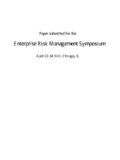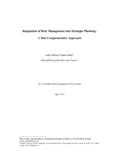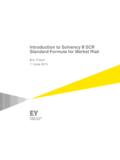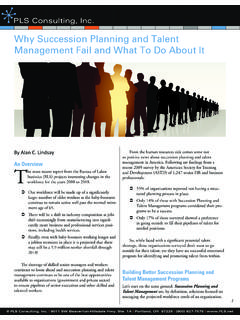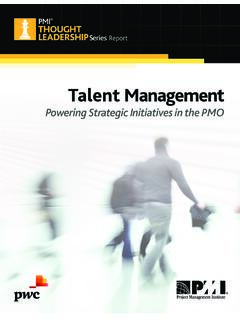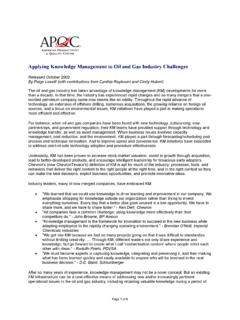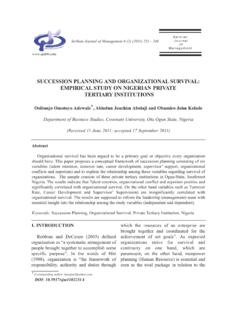Transcription of Managing Emerging Risks - An Oxymoron b-w …
1 2/22/20111 Beverly Barney, FSA, MAAA, CERAThe Prudential Insurance Company of AmericaMarch 16, 2011 Managing Emerging Risks ---An Oxymoron ?Agenda Emerging Risk Definition Emerging Risk management Basics Active Risk management Quarterly ReportsQyp Leading Indicators from the 2010 Survey Challenges and Next Steps2 Emerging Risk Definition A condition, situation or trend that could significantly impact the Company s financial strength, competitive position or reputation within the next 5 years. Emerging Risks involve a high degree of uncertainty. It is unclear where an Emerging risk will land on the loss of LossExpected LossUnexpected LossStress LossCovered by standard business stress the system but standard business continuation practices should stress the system; outside of normal coping Risk management Basics Objective: To establish a forward looking, comprehensive framework to manage Emerging Risks that could, at some point in the future; impair the Company s financial strength, competitive position or reputation.
2 Benefits Minimize surprises and earnings Identify early mitigation opportunities. Enable early recognition of Risks which might not be recognized as material in any one area, but which might affect several businesses and become significant to the Company. Identify and share best practices in Managing Emerging Risks . Strengthen the risk awareness/culture of the company through discussions about Emerging Risk management Basics (cont d) Principles: Emerging Risks will be managed by the area closest to taking those Risks . Utilize the current risk management structure wherever possible. Engage as many associates as possible from as many areas of the company as possible. Striveforconsistencyinapplyingdefinition andmeasurementtoenableStrive for consistency in applying definition and measurement to enable comparison. Keep reporting useful, as simple as possible and frequent. Coordinate roles and responsibilities in Emerging event situations with other existing company Risk management Emerging Risks are identified through multiple internal and external activities.
3 For those to be actively managed, a subject matter expert is assigned as an Emerging Risk Manager. Initial information is provided:ffk Definition of Emerging risk. Areas of the Company likely to be impacted. Estimates of likelihood, impact and velocity (Please see Appendix). Current or future mitigation plans, if any. Leading Risk management (cont d) Quarterly information is subsequently provided: Has anything happened during the quarter regarding this risk? Have the status of the leading indicators changed? Have the scores of likelihood, impact or velocity changed? Should the company take action now? 7 Quarterly ReportsSummaryEmerging RisksImpact TypeVelocityMaterialityReputationalImpac tShort TermLongTerm Immediate Trend RecoverableNew ParadigmYNSignificantRegulatory Changes;;; ; ; ;Social Media;; ;; ; ;Failure of Critical Vendor(s);;;; ;Federal Health Reform Legislation;; ; ; ; ; ;Talent Retention Generation X;;; ;8 Quarterly Reports (cont d) Emerging RisksTalent Retention Generation XLikelihood:AImpact: BVelocity: CLeading Indicator(s): Increasing Generation X voluntary terminations.
4 Increasing ratio of Generation X to Baby Boomer Action: Talent acquisition and retention strategies. Effective succession X3rdQuarter Update: The ratio of Gen X associates to Baby Boomers and Matures within Prudential remains favorable. We are now tracking Generation X voluntary terminations (turnover rates) as a leading indicator. We will continue to monitor this quarter over Reports (cont d) Emerging RisksSocial MediaLikelihood:XImpact: YVelocity: ZTOTAL QLeading Indicator(s): Withdrawal of financial service companies from platforms. New rules and regulations being considered by regulatory Action: Development of policy, standards and training. Constantly monitoring media for mentions of Prudential and its businesses. Committee reviewing all potential Social Media Update: X corporate functions and Y businesses have adopted social media standards. In addition, in late July the company rolled out its social media Web based training program.
5 Designed to educate employees about Prudential s Social Media Policy as well as how to avoid some pitfalls when using social media Reports (cont d) Emerging RisksFederal Health Reform LegislationLikelihood:MImpact: NVelocity: LTOTAL PLeading Indicator(s): None recognizedMitigating Action: Impact being identified as regulations are developed. Participation in regulation Update:dhhldlldiifhl HHS and the NAIC have released rules related to provisions of the law effective September 23, 2010. Employee Benefits has made all the necessary revisions to comply with the law for the new Plan year. Individual health (discontinued business) is working with TPAs to implement required changes. Law Department continues to monitor the various reporting requirements. 11 Leading Indicators from the 2010 Survey 52% of respondents (40% in 2009) indicated that they select leading indicators to measure changing likelihood for some or all of their identified Emerging Risks .
6 Examples include: CDS spreads as an indicator of credit risk, including sovereign debt. WHO and CDC information on flu outbreaks for a pandemic. 56% of respondents (49% in 2009) who indicated that they identify leading p()yygindicators of Emerging Risks also have criteria for when to take action on some or all of their Emerging Risks . Examples include: Risk appetite and tolerance limits. Prioritization based on assessed impact relative to ERM internal impact 81% of respondents (73% in 2009) measure, monitor or mitigate some or all of their identified Emerging Risks . Examples include: Internal team prioritizes Emerging Risks for tracking, monitoring and mitigation. For rising interest rates as a leading indicator to inflation: model risk; monitor interest rates; hedge tail Indicators from the 2010 Survey (cont d)13 Challenges and Next Steps Challenges: What are the criteria for promoting an Emerging risk to active management ?
7 When should we take a risk off of the list of Emerging Risks either because it may no longer be a risk or because it is no longer Emerging ? How should we involve associates in multiple locations? Can/should we refine scoring methodology? When should we use scenario analysis? Next Steps: Expand brainstorming to include associates in various locations. Analyze correlations among Emerging Risks to identify potentially offsetting Risks and/or leading indicators. Document business requirements and build of Likelihood, Impact and VelocityConsistent measurement of Emerging Risks allows comparison and prioritization as well as recognition of an increase or decrease in an Emerging risk s emergence . This score considers three factors: likelihood, impact and velocity. The exact numerical value of any particular Emerging risk s score is not as important as its position relative to other Emerging Risks . Following are the criteria:A.
8 Likelihoodis the probability of the risk materializing, that is, how soon could it impact us?1) Within the next year: X2) 1 to 3 years: Y3) 3 to 5 years: ZB. Impactis the potential dollar amount of loss if the identified Emerging risk is realized, that is, how muchcouldithurtus?Appendixmuch could it hurt us?1) Greater than $A and/or significant reputational damage: D2) $B to $A and/or moderate reputational damage: E3) $C to $B and/or limited reputational damage: F4) Less than $C and/or no reputational damage: GC. Velocityis how quickly the Emerging risk could impact us once it begins to be realized ( , current longevity improvement would be considered a trend; longevity improvement from a discovery to cure cancer would be immediate).1) Immediate: H2) Trend: I

